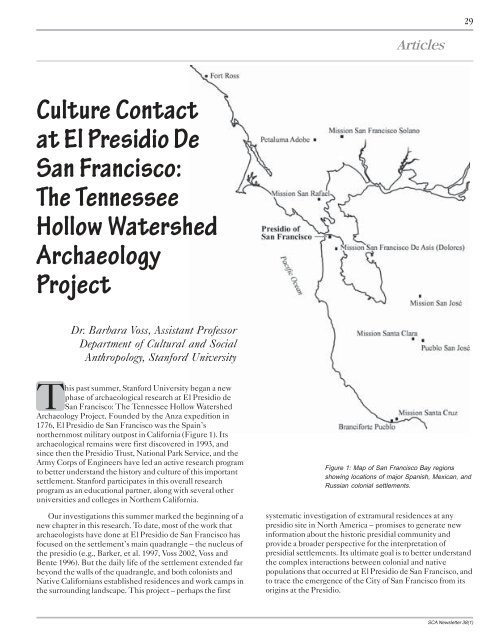March 2004 - Society for California Archaeology
March 2004 - Society for California Archaeology
March 2004 - Society for California Archaeology
You also want an ePaper? Increase the reach of your titles
YUMPU automatically turns print PDFs into web optimized ePapers that Google loves.
29<br />
Articles<br />
Culture Contact<br />
at El Presidio De<br />
San Francisco:<br />
The Tennessee<br />
Hollow Watershed<br />
<strong>Archaeology</strong><br />
Project<br />
Dr. Barbara Voss, Assistant Professor<br />
Department of Cultural and Social<br />
Anthropology, Stan<strong>for</strong>d University<br />
This past summer, Stan<strong>for</strong>d University began a new<br />
phase of archaeological research at El Presidio de<br />
San Francisco: The Tennessee Hollow Watershed<br />
<strong>Archaeology</strong> Project. Founded by the Anza expedition in<br />
1776, El Presidio de San Francisco was the Spain’s<br />
northernmost military outpost in Cali<strong>for</strong>nia (Figure 1). Its<br />
archaeological remains were first discovered in 1993, and<br />
since then the Presidio Trust, National Park Service, and the<br />
Army Corps of Engineers have led an active research program<br />
to better understand the history and culture of this important<br />
settlement. Stan<strong>for</strong>d participates in this overall research<br />
program as an educational partner, along with several other<br />
universities and colleges in Northern Cali<strong>for</strong>nia.<br />
Our investigations this summer marked the beginning of a<br />
new chapter in this research. To date, most of the work that<br />
archaeologists have done at El Presidio de San Francisco has<br />
focused on the settlement’s main quadrangle – the nucleus of<br />
the presidio (e.g., Barker, et al. 1997, Voss 2002, Voss and<br />
Bente 1996). But the daily life of the settlement extended far<br />
beyond the walls of the quadrangle, and both colonists and<br />
Native Cali<strong>for</strong>nians established residences and work camps in<br />
the surrounding landscape. This project – perhaps the first<br />
Figure 1: Map of San Francisco Bay regions<br />
showing locations of major Spanish, Mexican, and<br />
Russian colonial settlements.<br />
systematic investigation of extramural residences at any<br />
presidio site in North America – promises to generate new<br />
in<strong>for</strong>mation about the historic presidial community and<br />
provide a broader perspective <strong>for</strong> the interpretation of<br />
presidial settlements. Its ultimate goal is to better understand<br />
the complex interactions between colonial and native<br />
populations that occurred at El Presidio de San Francisco, and<br />
to trace the emergence of the City of San Francisco from its<br />
origins at the Presidio.<br />
SCA Newsletter 38(1)

















